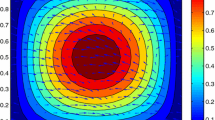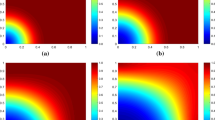Abstract
In Guo et al. (Appl Math Comput 259:88–105, 2015), a nonconservative local discontinuous Galerkin (LDG) method for both flow and transport equations was introduced for the one-dimensional coupled system of compressible miscible displacement problem. In this paper, we will continue our effort and develop a conservative LDG method for the problem in two space dimensions. Optimal error estimates in \(L^{\infty }(0, T; L^{2})\) norm for not only the solution itself but also the auxiliary variables will be derived. The main difficulty is how to treat the inter-element discontinuities of two independent solution variables (one from the flow equation and the other from the transport equation) at cell interfaces. Numerical experiments will be given to confirm the accuracy and efficiency of the scheme.


Similar content being viewed by others

References
Bartels, S., Jensen, M., Müller, R.: Discontinuous Galerkin finite element convergence for incompressible miscible displacement problem of low regularity. SIAM J. Numer. Analy. 47, 3720–3743 (2009)
Bassi, F., Rebay, S.: A high-order accurate discontinuous finite element method for the numerical solution of the compressible Navier–Stokes equations. J. Comput. Phys. 131, 267–279 (1997)
Bell, J., Dawson, C.N., Shubin, G.R.: An unsplit high-order Godunov scheme for scalar conservation laws in two dimensions. J. Comput. Phys. 74, 1–24 (1988)
Castillo, P., Cockburn, B., Perugia, I., Schötzau, D.: Superconvergence of the local discontinuous Galerkin method for elliptic problems on cartesian grids. SIAM J. Numer. Anal. 39, 264–285 (2001)
Ciarlet, P.: The Finite Element Method for Elliptic Problem. North Holland, Amsterdam (1975)
Cockburn, B., Shu, C.-W.: The local discontinuous Galerkin method for time-dependent convection-diffusion systems. SIAM J. Numer. Anal. 35, 2440–2463 (1998)
Cui, M.: Analysis of a semidiscrete discontinuous Galerkin scheme for compressible miscible displacement problem. J. Comput. Appl. Math. 214, 617–636 (2008)
Douglas Jr., J., Roberts, J.E.: Numerical methods for a model for compressible miscible displacement in porous media. Math. Comput. 41, 441–459 (1983)
Douglas Jr., J., Russell, T.F.: Numerical methods for convection-dominated diffusion problems based on combining the method of characteristic with finite element of finite difference procedures. SIAM J. Numer. Anal. 19, 871–885 (1982)
Douglas Jr., J., Ewing, R.E., Wheeler, M.F.: A time-discretization procedure for a mixed finite element approximation of miscible displacement in porous media. RAIRO Anal. Numér. 17, 249–256 (1983)
Douglas Jr., J., Ewing, R.E., Wheeler, M.F.: The approximation of the pressure by a mixed method in the simulation of miscible displacement. RAIRO Anal. Numér. 17, 17–33 (1983)
Ewing, R.E., Russell, T.F., Wheeler, M.F.: Convergence analysis of an approximation of miscible displacement in porous media by mixed finite elements and a modified method of characteristics. Comput. Methods Appl. Mech. Eng. 47, 73–92 (1984)
Gelfand, I.M.: Some questions of analysis and differential equations. Am. Math. Soc. Transl. 26, 201–219 (1963)
Guo, H., Zhang, Q., Wang, J.: Error analysis of the semi-discrete local discontinuous Galerkin method for compressible miscible displacement problem in porous media. Appl. Math. Comput. 259, 88–105 (2015)
Guo, H., Yu, F., Yang, Y.: Local discontinuous Galerkin method for incompressible miscible displacement problem in porous media. J. Sci. Comput. 71, 615–633 (2017)
Hurd, A.E., Sattinger, D.H.: Questions of existence and uniqueness for hyperbolic equations with discontinuous coefficients. Trans. Am. Math. Soc. 132, 159–174 (1968)
Ji, L., Xu, Y.: Optimal error estimates of the local discontinuous Galerkin method for Willmore flow of graphs on Cartesian meshes. Int. J. Numer. Anal. Model. 8, 252–283 (2011)
Johnson, C.: Streamline Diffusion Methods for Problems in Fluid Mechanics. Finite Element in Fluids VI. Wiley, New York (1986)
Li, X., Rui, H., Xu, W.: A new MCC–MFE method for compressible miscible displacement in porous media. J. Comput. Appl. Math. 302, 139–156 (2016)
Rivière, B.: Discontinuous Galerkin finite element methods for solving the miscible displacement problem in porous media. In: Ph.D. thesis, The University of Texas at Austin (2000)
Shu, C.-W., Osher, S.: Efficient implementation of essentially non-oscillatory shock-capturing schemes. J. Comput. Phys. 77, 439–471 (1988)
Sun, S., Rivière, B., Wheeler, M.: A combined mixed finite element and discontinuous Galerkin method for miscible displacement problem in porous media. In: Chan, T., et al. (eds.) Recent Progress in Computational and Applied PDEs, pp. 323–351. Kluwer Academic Publishers, Plenum Press, Dordrecht, NewYork (2002)
Sun, S., Wheeler, M.: Discontinuous Galerkin methods for coupled flow and reactive transport problems. Appl. Numer. Math. 52, 273–298 (2005)
Wang, H., Shu, C.-W., Zhang, Q.: Stability and error estimates of local discontinuous Galerkin methods with implicit-explicit time-marching for advection-diffusion problems. SIAM J. Numer. Anal. 53, 206–227 (2015)
Wang, H., Shu, C.-W., Zhang, Q.: Stability analysis and error estimates of local discontinuous Galerkin methods with implicit-explicit time-marching for nonlinear convection-diffusion problems. Appl. Math. Comput. 272, 237–258 (2016)
Wang, H., Wang, S., Zhang, Q., Shu, C.-W.: Local discontinuous Galerkin methods with implicit-explicit time marching for multi-dimensional convectiondiffusion problems. ESAIM: M2AN 50, 1083–1105 (2016)
Xu, Y., Shu, C.-W.: Local discontinuous Galerkin methods for nonlinear Schrodinger equations. J. Comput. Phys. 205, 72–97 (2005)
Xu, Y., Shu, C.-W.: Local discontinuous Galerkin methods for the Kuramoto–Sivashinsky equations and the Ito-type coupled KdV equations. Comput. Methods Appl. Mech. Eng. 195, 3430–3447 (2006)
Yan, J., Shu, C.-W.: A local discontinuous Galerkin method for KdV type equations. SIAM J. Numer. Anal. 40, 769–791 (2002)
Yang, Y., Shu, C.-W.: Analysis of optimal superconvergence of local discontinuous Galerkin method for one-dimensional linear parabolic equations. J. Comput. Math. 33, 323–340 (2015)
Yuan, Y.: Characteristic finite element methods for positive semidefinite problem of two phase miscible flow in three dimensions. Chin. Sci. Bull. 22, 2027–2032 (1996)
Zhang, J., Yang, D., Shen, S., Zhu, J.: A new MMOCAA-MFE method for compressible miscible displacement in porous media. Appl. Numer. Math. 80, 65–80 (2014)
Author information
Authors and Affiliations
Corresponding author
Additional information
Supported by National Natural Science Foundation of China Grants 11571367 and 11601536, and the Fundamental Research Funds for the Central Universities and Michigan Technological University Research Excellence Fund Scholarship and Creativity Grant 1605052.
Appendix: Proof of Lemma 3.1
Appendix: Proof of Lemma 3.1
Recall that we have chosen the initial condition \(c_{h}^{0}=P^{+}c_{0}, \mathbf {u}_{h}^{0}=\mathbf {\Pi ^{-}}\mathbf {u}_{0}\), where \(\mathbf {u}_{0}=-a(c_{0})\nabla p_0\), and \(\widehat{p_{h}}=p_{h}^{+}, \widehat{\mathbf {u}_{h}}=\mathbf {u}_{h}^{-}, \widehat{\mathbf {z}_{h}}=\mathbf {z}_{h}^{-}, \widehat{c_{h}}=c_{h}^{+}\). For simplicity, we will drop the 0 in the superscripts and subscripts in this section. It is clear that (3.15) and (3.16) hold. Taking the test function \(\zeta ={\xi _{p}}_{t}\) and summing over K in (4.10), we have
where we have used \(\mathbf {u}_{h}=\mathbf {\Pi ^{-}}\mathbf {u}, \widehat{\mathbf {u}_{h}}=\mathbf {u}_{h}^{-}\) and the property of the projection (4.3). Using the Schwartz inequality, we can get
By Lemma 4.2 and (3.15), we easily prove
Similarly, taking the test function \(\mathbf {w}=\varvec{\xi }_{s}\) and summing over K in (4.7), we have
where we have used \(c_{h}=P^{+}c\). Using the Schwartz inequality and the Lemma 4.3, we can get
By Lemma 4.2, we easily prove
By the standard approximation results, (3.17) and (3.18) hold. At last we estimate \(p-p_{h}\), following the technique in [17]. By (3.9) the initial data \(p_{h}\) is the solution of the following equations
and also satisfies
From (4.9), we have
We use \(\mathbf {u}_{h}\) to find a well-defined \(p_{h}\), and we only need to prove the uniqueness. If there are two solutions \(p_{1}\) and \(p_{2}\) satisfying (A.7) and (A.8), then we can easily get
We consider the elliptic linear problem
subject to periodic boundary conditions. To make the problem well-defined, we assume that the average of \({\xi }^{*}\) on \(\Omega \) is a given constant and that of \(\eta ^{*}\) is zero. We have the elliptic regularity result
Taking \(\eta ^{*}=p_{1}-p_{2}\) and \(\widehat{p_i}=p_i^{+}, i=1,2\), we get
where the third step follows from (A.10) and the last equality is based on integration by parts. We take \(\Pi \varvec{\zeta }^{*}=\Pi ^{-}\varvec{\zeta }^{*}\) and sum over K. By the continuity of \(\varvec{\zeta }^{*}\) and the definition of the projection \(\Pi ^{-}\), we obtain
Then we get \(p_{1}=p_{2}\). We have proved that \(p_{h}\) is well-defined. In the following, we estimate \(\Vert p-p_{h}\Vert \). We use the same technique above and take \(\eta ^{*}=p-p_{h}\) to obtain
where the third one follows from (A.9) and the fourth equality is based on the integrate by parts. Recalling that \(\widehat{p_{h}}=p_{h}^{+}\), we take \(\Pi \varvec{\zeta }^{*}=\Pi ^{-}\varvec{\zeta }^{*}\) and sum over K. By the continuity of \(\varvec{\zeta }^{*}\) and the definition of the projection \(\varvec{\Pi }^{-}\), we obtain
which further implies
Rights and permissions
About this article
Cite this article
Yu, F., Guo, H., Chuenjarern, N. et al. Conservative Local Discontinuous Galerkin Method for Compressible Miscible Displacements in Porous Media. J Sci Comput 73, 1249–1275 (2017). https://doi.org/10.1007/s10915-017-0571-z
Received:
Revised:
Accepted:
Published:
Issue Date:
DOI: https://doi.org/10.1007/s10915-017-0571-z



